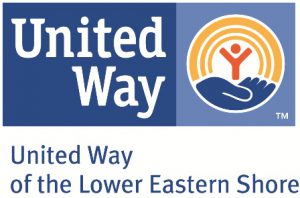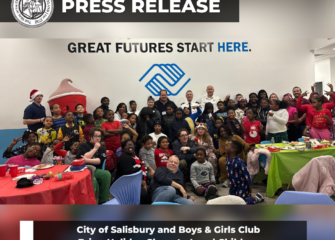
New report and interactive tools reveal that federal poverty data undercounts how many children of all races are growing up amid financial insecurity.
SALISBURY, MD – The majority of Maryland’s Black and Latinx children — 61% and 68% respectively — lived in households that couldn’t afford the basics in 2019, compared to 31% of White children, according to a new report from United Way of the Lower Eastern Shore and its research partner United For ALICE. Locally, for Black and Latinx children in the tri-county Lower Shore area (Worcester, Wicomico, and Somerset Counties) it is 63% and 61% respectively, compared to 39% white children. In the Upper-Shore area (which includes Dorchester County), it is 78% Black, 83% Latinx, and 26% White children who couldn’t afford the basics in 2019.
The new report, ALICE in Focus: Children, reveals the disproportionate impact of financial hardship on the state’s Black and Latinx children, while also challenging the reliance on federal poverty guidelines for eligibility for assistance programs. The report finds traditional measures of poverty have severely undercounted the number of children of all races growing up in financially insecure households.
While 12% of all children in Maryland were deemed in poverty in 2019, the report shows that 35% – almost three times as many – lived in families defined as ALICE (Asset Limited, Income Constrained, Employed). ALICE households earn more than the Federal Poverty Level, but less than what it costs to live and work in the modern economy. Combined, 47% of Maryland’s children lived in households below the ALICE Threshold, with income that doesn’t meet the basic costs of housing, childcare, health care, transportation and a smartphone plan. Locally, between 42 and 49% of children living in families below the ALICE threshold.
“Undercounting the number of children who are at risk can have lifelong consequences,” said Pam Gregory, President and CEO of United Way of the Lower Eastern Shore. “Thousands of children are not receiving critical supports for stable housing, food, and quality education, all of which can inhibit healthy child development.”
Because ALICE households often earn too much to qualify for public assistance, the report finds that more than 425,000 at-risk children in Maryland didn’t access the Supplemental Nutrition Assistance Program or SNAP. Locally, between 29 and 31% of the families below the ALICE threshold didn’t access SNAP benefits.
Other findings from ALICE in Focus: Children include:
• Having two working parents didn’t guarantee financial stability: Locally, 22 to 29% of children lived in a home with two working adults whose income didn’t meet the cost of basic needs in 2019.
• Among local households who rented their homes, 76% were below the ALICE Threshold.
• 64% of Somerset, Worcester, and Wicomico County households below the ALICE threshold had no access to high-speed internet at home.
“Having accurate, complete data is the foundation for designing equitable solutions,” said United For ALICE National Director Stephanie Hoopes, Ph.D. “COVID-19 hit ALICE families so much harder than others because they struggle to build savings yet often don’t qualify for financial assistance.”
More data is available through the ALICE in Focus: Children interactive data dashboard – which provides filters for regional and local geographies, age, race, disability status, living arrangements and household work status. Visit UnitedForALICE.org/Focus-Children.
ALICE in Focus: Children is the first installment in the ALICE in Focus Research Series, which draws from the U.S. Census Bureau’s American Community Survey (ACS) Public Use Microdata Samples (PUMS). Each installment in the series will highlight a specific segment within the ALICE demographic. Upcoming topics include people with disabilities and veterans.
About United Way of the Lower Eastern Shore:
United Way of the Lower Eastern Shore (UWLES), now in its 77th year of local service, harnesses the power of our community to advance health, education and financial stability for all neighbors in Dorchester, Somerset, Wicomico and Worcester counties. UWLES helps empower Lower Shore residents to achieve better health by addressing barriers to care, educational success by reducing the achievement gap between low- and middle-income students, and financial stability by advancing the economic security of families and individuals. UWLES provides direct services, collaborates with local stakeholders, and supports 41 local nonprofits to strengthen the entire community, impacting 1 in every 3 individuals on the Lower Shore annually. For more information visit uwles.org.
About United For ALICE
United For ALICE is a driver of innovation, research and action to improve life across the country for ALICE (Asset Limited, Income Constrained, Employed) and for all. Through the development of the ALICE measurements, a comprehensive, unbiased picture of financial hardship has emerged. Harnessing this data and research on the mismatch between low-paying jobs and the cost of survival, ALICE partners convene, advocate and collaborate on solutions that promote financial stability at local, state and national levels. This grassroots ALICE movement, led by United Way of Northern New Jersey, has spread to 24 states and includes United Ways, corporations, nonprofits and foundations in Arkansas, Connecticut, Delaware, Florida, Hawai‘i, Idaho, Illinois, Indiana, Iowa, Louisiana, Maryland, Michigan, Mississippi, New Jersey, New York, Ohio, Oregon, Pennsylvania, Tennessee, Texas, Virginia, Washington, Washington, D.C., West Virginia and Wisconsin; we are United For ALICE. For more information, visit: UnitedForALICE.org.



